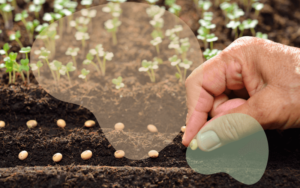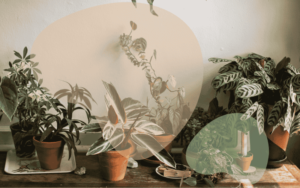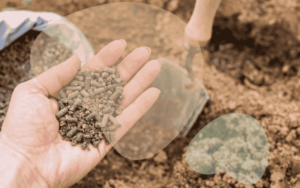Let’s talk about the less glamorous part of growing indoor and container plants; potting soil. It might not be an exciting topic, but the truth is, it determines whether your plants stay beautiful and healthy. Potting soils are designed to cater to the unique needs of plants grown in pots or containers. However, they are not made to support and nourish your plants for years and years.
Not all potting mixes are created equal! We’ll walk you through picking the right one for your plants and why it needs a little extra care over time. With a few simple tricks, you can keep your plants looking lush and healthy for longer.
What is potting soil?
Potting soil, also known as potting mix, is made up of various ingredients designed to create a healthy environment for potted plants. Even though these terms are often used interchangeably, they aren’t the same. Potting soil may or may not contain soil in it, whereas potting mix is a strictly soilless medium.
Potting mix is sterile, which helps to protect plants from harmful pathogens like fungi and diseases. Most commercial soilless potting mixes are peat-based, often made with reed or sedge peat and adjusted to the right pH with lime. Fresh out of the bag, they look rich and well-balanced, sometimes even enhanced with fertilizers or water-retention crystals. However, these mixes don’t stay good forever, they decompose over time. After one or two seasons, your plants may grow slower or lose their vibrancy.
Why does this happen? The ingredients in the potting mix are organic, and like any organic material, they break down over time. As the decomposition happens, the structure of the potting mix changes, resulting in compaction and airflow which means less drainage. These conditions make it harder for plant roots to thrive.
This happens because purely peat-based potting mixes aren’t designed for long-term plant health—they’re designed for convenience. They’re lightweight, easy to package, and inexpensive to produce, making them a practical choice for manufacturers and retailers. But for plants? Not so much.
Why Decomposing Potting Soil Can Harm Your Plants
When the potting mix decomposes, it can negatively impact your plants in many ways:
Compaction
Compaction occurs when soil becomes heavy and tightly packed, making it difficult for roots to grow and access oxygen. This commonly happens in older potting mixes, especially those containing peat moss. As the mix decomposes the particles compact themselves around the plant roots, depriving them of oxygen. Just as plants need water and nutrients, they also need proper airflow in the root zone. Without it, they struggle—and ultimately, a plant lacking aeration will slowly die.
Poor Drainage
As the soil particles get smaller, the soil loses its porosity making it harder for water to drain through the soil.
Salt accumulates
The poor drainage in the potting mix leads to salts from mineral water and fertilizer deposits being trapped in the soil. Over time, this buildup can stress the plant and even burn its roots, making it harder for the plant to absorb water and nutrients.
Simple Ways to Improve Your Potting Soil
Take these steps to ensure your plants have the soil they need:
- If you are using peat-based potting mix, repot every year. You don’t have to throw the old one away. You can replenish the old potting mix by mixing it with fresh soil in a 50-50 ratio.
- Flush the soil monthly to leach out accumulated mineral salts and fertilizer deposits. Make sure the water drains out entirely from the bottom.
- Mix in more nutrients to improve store-bought peat-based mixes. You can add perlite and some organic matter to the potting soil, this will add porosity to the soil and improve its overall structure. You can add compost to the potting soil in a 20-80 or 50-50 ratio.
- A pro-gardner option would be to make your potting mix. This sounds like a lot of fun, but it’s not for beginners. To make your potting mix, you can combine the following ingredients- composted bark, coconut coir, peat, perlite, vermiculite, pumice, and other soil additives. Going this route only works if you have a more established plant collection and care routine. Making your potting soil is only economically viable if you do it at scale. This means buying things in bulk. Can you see where we are going with this?
What Do Your Indoor Plants Need From Soil?
Houseplants need a different type of soil than plants grown outside in the ground. Their roots grow within a confined space in pots, but the soil still has to perform essential functions to support life—retaining moisture while having good drainage so plants have access to water and air.
Potted and container plants rely entirely on their potting soil for nutrients. As you water your plants, nutrients leach out of the soil, which is why it is important to periodically add fertilizer. Additionally, soil pH plays a crucial role in plant health. Most pot plants need a slightly acidic to neutral pH (6.0 to 7.0) soil, while orchids, succulents, and cacti prefer even lower pH levels. The gardening supply store near you will probably have multiple options, so make sure you buy the right potting soil for your chosen plant types.




